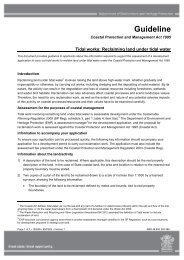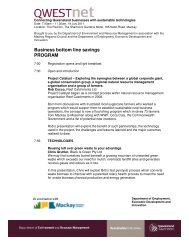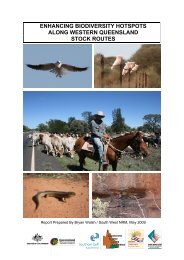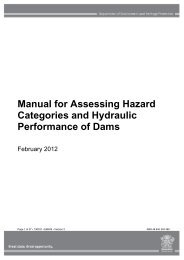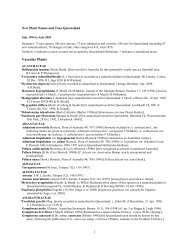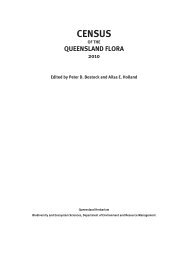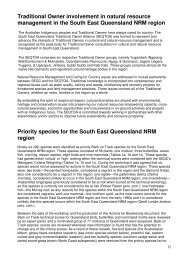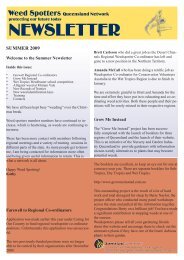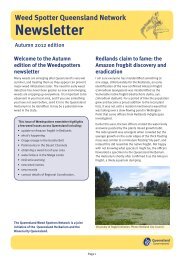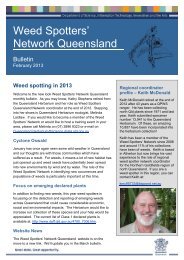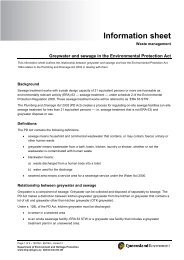Distribution, abundance and biology of Group V humpback whales ...
Distribution, abundance and biology of Group V humpback whales ...
Distribution, abundance and biology of Group V humpback whales ...
Create successful ePaper yourself
Turn your PDF publications into a flip-book with our unique Google optimized e-Paper software.
Variations in the <strong>abundance</strong> <strong>of</strong> prey on feeding grounds<br />
may be directly related to the year-to-year variation in<br />
reproductive rates (Clapham 1996) <strong>and</strong> <strong>abundance</strong> on the<br />
wintering grounds (Chaloupka <strong>and</strong> Osmond 1999). Wiley<br />
<strong>and</strong> Clapham (1993) tested the hypothesis <strong>of</strong> whether or<br />
not maternal condition affects the sex ratio <strong>of</strong> <strong>of</strong>fspring.<br />
Their investigation concluded that the sex ratio <strong>of</strong> calves<br />
born to females in “superior” condition, or that had a calving<br />
interval <strong>of</strong> three years, was biased toward sons.<br />
7.4 Male reproduction <strong>and</strong> behaviour<br />
Mature male <strong>humpback</strong> <strong>whales</strong> depart the feeding grounds<br />
with mature females (Dawbin 1966). Humpback whale<br />
courting behaviour includes elaborate songs sung by males<br />
during their migration to (Charif et al.2001) <strong>and</strong> on wintering<br />
grounds (Helweg et al.1998b). Helweg <strong>and</strong> Herman (1994)<br />
found there was no difference between singing behaviour<br />
during day <strong>and</strong> night in deep water, although Au et al.(2000)<br />
found that in shallow water <strong>of</strong>f Maui there was a change in<br />
the occurrence <strong>of</strong> singing behaviour with time <strong>of</strong> day,<br />
with a peak at night.<br />
The song patterns produced by singing <strong>humpback</strong> <strong>whales</strong><br />
depend on where individuals live, with populations inhabiting<br />
different ocean basins normally singing quite distinct songs<br />
(Noad et al.2000). Singing <strong>whales</strong> have been used to<br />
determine migratory routes (Charif et al.2001), demonstrate<br />
interchange between populations (Helweg et al.1998)<br />
<strong>and</strong> as an index <strong>of</strong> <strong>abundance</strong> (Noad 1998). Mobley et<br />
al.(1988) played a variety <strong>of</strong> sounds to <strong>humpback</strong> <strong>whales</strong><br />
on wintering grounds <strong>and</strong> concluded that the different rates<br />
<strong>of</strong> behavioural response were attributed to the behaviour<br />
<strong>of</strong> sexually active males seeking to affi liate with sexually<br />
mature females.<br />
A study conducted by Frankel et al.(1995) supported<br />
the hypothesis that song functions to maintain distance<br />
between singers <strong>and</strong> McCauley et al.(1995) give a succinct<br />
description <strong>of</strong> the song <strong>and</strong> hearing capabilities<br />
<strong>of</strong> <strong>humpback</strong>s.<br />
Richardson et al.(1995) is a comprehensive review <strong>of</strong><br />
acoustics <strong>and</strong> how they relate to marine mammals. The<br />
information presented includes specifi c references to<br />
<strong>humpback</strong> <strong>whales</strong>. They concluded there is no research<br />
to demonstrate that acoustics adversely affects <strong>humpback</strong><br />
<strong>whales</strong>. However, more recent research demonstrates<br />
that <strong>humpback</strong>s alter their behaviour in response to<br />
anthropogenic noise (Miller et al.2000). Williams et al.(2002)<br />
concluded that weakening or not enforcing the minimum<br />
approach distances for the whale watching <strong>of</strong> orcas in<br />
Canada would result in higher levels <strong>of</strong> disturbance.<br />
Corkeron (1995) demonstrated that <strong>humpback</strong>s in Hervey<br />
Bay altered their behaviour when vessels were within 300m.<br />
This <strong>and</strong> several other studies show that the behaviour<br />
<strong>of</strong> <strong>humpback</strong>s is altered by the presence <strong>of</strong> vessels but it<br />
remains uncertain if the effect is detrimental (Bauer <strong>and</strong><br />
Herman 1986; Baker <strong>and</strong> Herman 1989; Bryden et al.1988).<br />
8 Population estimates <strong>and</strong> rates<br />
<strong>of</strong> increase<br />
Reviews <strong>of</strong> international data indicate a strong recovery<br />
in most studied <strong>humpback</strong> whale populations (Best 1993<br />
<strong>and</strong> Clapham 1999b). Paterson et al.(1994) suggests that<br />
the level <strong>of</strong> recovery <strong>of</strong> the <strong>Group</strong> V population, in the<br />
post-whaling period, is due to the stock experiencing no<br />
detrimental environmental factors.<br />
8.1 Southern hemisphere population<br />
estimates<br />
During 1933–1939, the estimated total number <strong>of</strong><br />
southern hemisphere baleen numbered 220,000–340,000.<br />
Approximately 10 percent <strong>of</strong> the southern hemisphere<br />
stock <strong>of</strong> baleen <strong>whales</strong> was <strong>humpback</strong> <strong>whales</strong>, <strong>and</strong> the<br />
ratio between the groups I–V was considered to be<br />
1:1:2:3:3 respectively (Matthews 1957 cited Chittleborough<br />
1965). Based on these estimates the <strong>Group</strong> V population<br />
could be estimated at 22,000–34,000 individuals for<br />
1933–1939 (Figure 8).<br />
8.2 <strong>Group</strong> V population estimates<br />
Figure 8 is a summary <strong>of</strong> the population estimates <strong>and</strong><br />
illegal catches by the Soviet fl eet for <strong>Group</strong> V <strong>humpback</strong>s<br />
during 1930–2005. Chittleborough (1965) estimates the<br />
<strong>Group</strong> V pre-whaling population numbered approximately<br />
10,000 individuals. By 1960, he estimated a population size<br />
<strong>of</strong> only 500 individuals. In 1963, the International Whaling<br />
Commission (IWC) imposed a ban on whaling, <strong>and</strong> in<br />
1964 the <strong>Group</strong> V population was estimated at just 400<br />
individuals. Until 1963, <strong>humpback</strong> population estimates<br />
were derived by modelling the fi sheries-based catch per<br />
unit effort data (Chittleborough 1965).<br />
Chittleborough (1965) compared population estimates<br />
derived by two methods <strong>and</strong> argues that for the estimate<br />
to be correct using the DeLury method, a further 5000<br />
<strong>humpback</strong>s would have had to been fi shed during the years<br />
1960 <strong>and</strong> 1961. Only 302 <strong>and</strong> 270 <strong>whales</strong> were reported<br />
to the IWC for each <strong>of</strong> those years. Although there is some<br />
uncertainty in these estimates, it is clear that during the late<br />
1950s <strong>and</strong> early 1960s, the <strong>Group</strong> V population experienced<br />
a signifi cant decline in numbers.<br />
Recent data presented by Mikhalev (2000) supports<br />
DeLury’s population estimate discussed by Chittleborough<br />
(1965). Mikhalev (2000) presented data collected by two<br />
Soviet vessels illegally whaling during the summer season<br />
<strong>of</strong> 1959 in the Antarctic Area V. The Russian vessels<br />
signifi cantly exceeded the quota for all countries by illegally<br />
fi shing a total <strong>of</strong> 11,605 individuals from the <strong>Group</strong> V<br />
population.<br />
Chittleborough (1965) estimated that the <strong>Group</strong> V population<br />
would take 36–63 years to regain its unfi shed status <strong>of</strong><br />
10,000 individuals. However in 1998, 33 years later, the<br />
<strong>Group</strong> V population was estimated at 4000 individuals<br />
(Paterson cited QDEH 1999). If a constant rate <strong>of</strong> increase<br />
is assumed, the 1962 population estimate <strong>of</strong> 500 individuals<br />
would have to have increased at a rate <strong>of</strong> approximately<br />
8 percent a year to reach its unfi shed state in 36 years.<br />
The rate <strong>of</strong> increase for the population to reach its unfi shed<br />
state in 63 years is just 4·8 percent a year. However,<br />
Mikhalev (2000) details the large-scale illegal Soviet catch<br />
data for the late 1960s <strong>and</strong> illustrates that the catches <strong>of</strong><br />
<strong>humpback</strong> on their feeding grounds during 1963–1968<br />
exceeds the population estimates derived by Chittleborough<br />
(1965). The population estimates for this period are being<br />
revised to account for the illegal catches by the Soviet fl eet<br />
(pers. comm. P Corkeron 2002).<br />
14 • <strong>Distribution</strong>, <strong>abundance</strong> <strong>and</strong> <strong>biology</strong> <strong>of</strong> <strong>Group</strong> V <strong>humpback</strong> <strong>whales</strong> Megaptera novaeangliae: A review • August 2002



